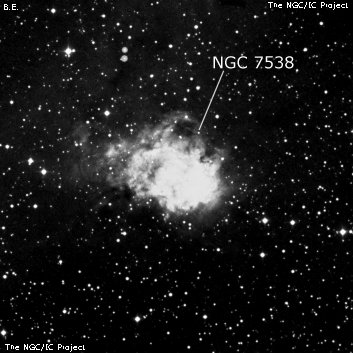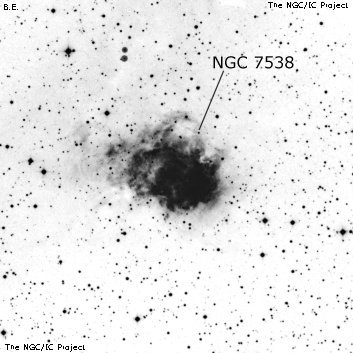NGC/IC Project Restoration Effort
(This is a very very beta version)
NGC7538


Basic Information
Location and Magnitude
Right Ascension: 23:13:38.0
Declination: +61:30:42
Constellation: CEP
Visual Magnitude:
Historic Information
Discoverer: Herschel W.
Year of discovery: 1787
Discovery aperture: 18.7
Observational
Summary description: vF, L, 2 pB st inv
Sub-type: EN
Corwin's Notes
=====
NGC 7538 is an HII region discovered by WH. He notes the two brightest stars
involved, but apparently saw the nebula as a single object. Indeed it is, of
course, but it has two lobes that appear on the DSS images. I've given an
approximate position for the northeastern lobe, and have adopted the position
of an embedded star in the southwestern lobe. For the nebula itself, I've
simply taken the mean value. The resulting position is coincidentally close
to the northeastern of WH's two stars. I note, however, that there are faint
streamers and plumes on to the northeast.
Steve's Notes
=====
NGC 7538
18" (9/3/08): at 115x, this HII region appears bright, fairly large, surrounding two mag 11.5 stars SW-NE with a faint star to the west of the SW star. The main portion of the nebulosity is elongated SW-NE and extends 3'x2'. Using an OIII filter, fainter nebulosity extends on the NE side, making an oval 4.5'x3'. The brightest portion is on the southwest side and this high surface brightness area encases the faint star mentioned above.
17.5" (8/10/91): fairly large elongated emission nebula 2.0'x0.75' oriented NW-SE. Surrounds two mag 11.5 stars oriented SW-NE (PA = 35¡) with a separation of 30". The nebulosity extends SW of the pair and is brightest just west of the pair. A mag 15 star is at the SW end and a mag 14 star is 30" W of the southern mag 11.5 star. At 100x using an OIII filter the nebulosity is very bright and a fainter glow also extends east of the pair to a size of 3'x2'.
8": faint nebulosity with two mag 12 stars involved. Appears elongated and fairly large. Easy to view with averted.



